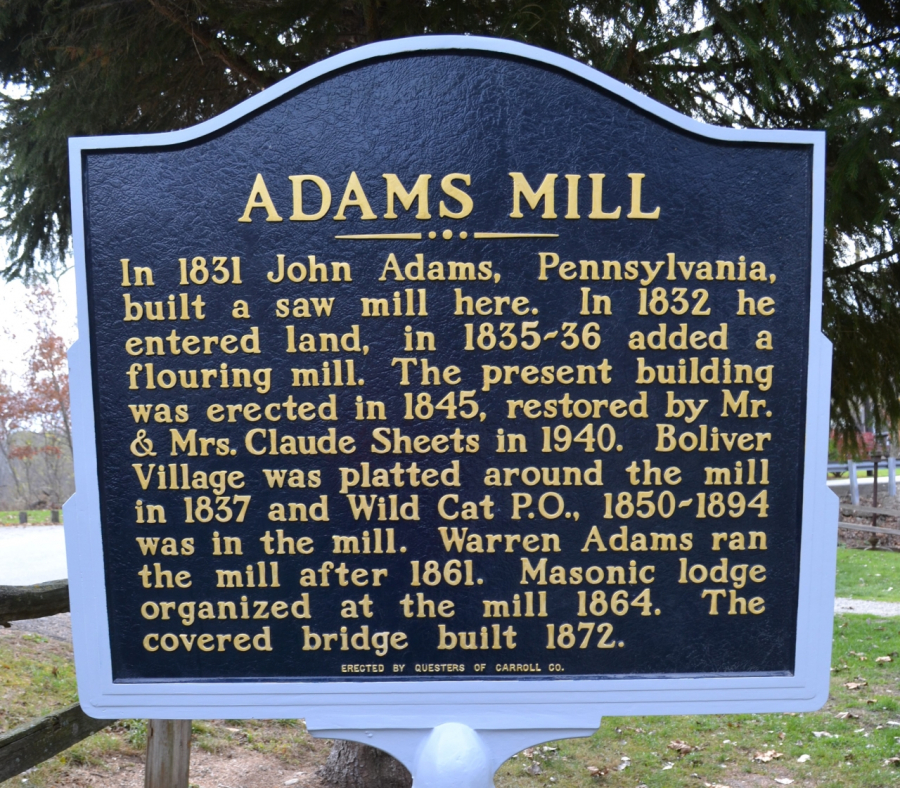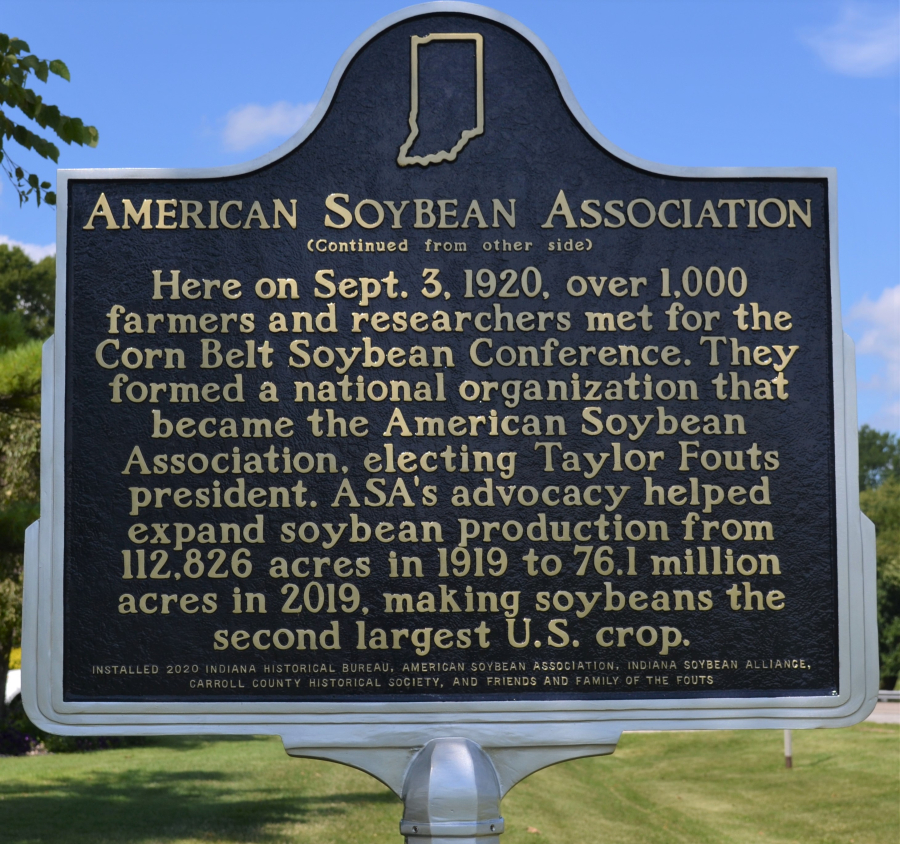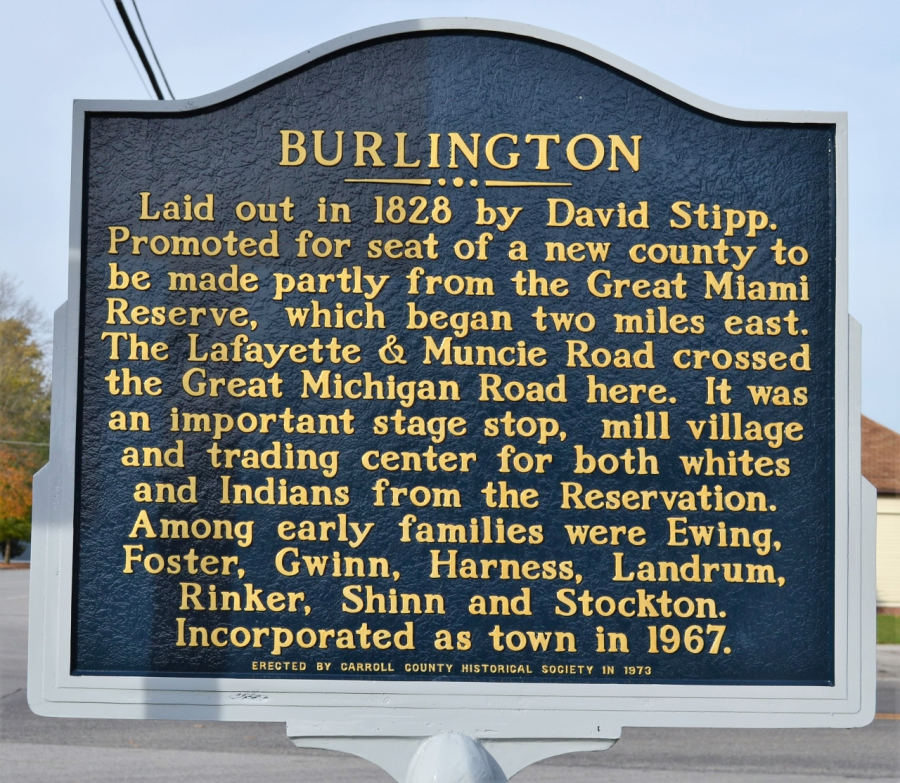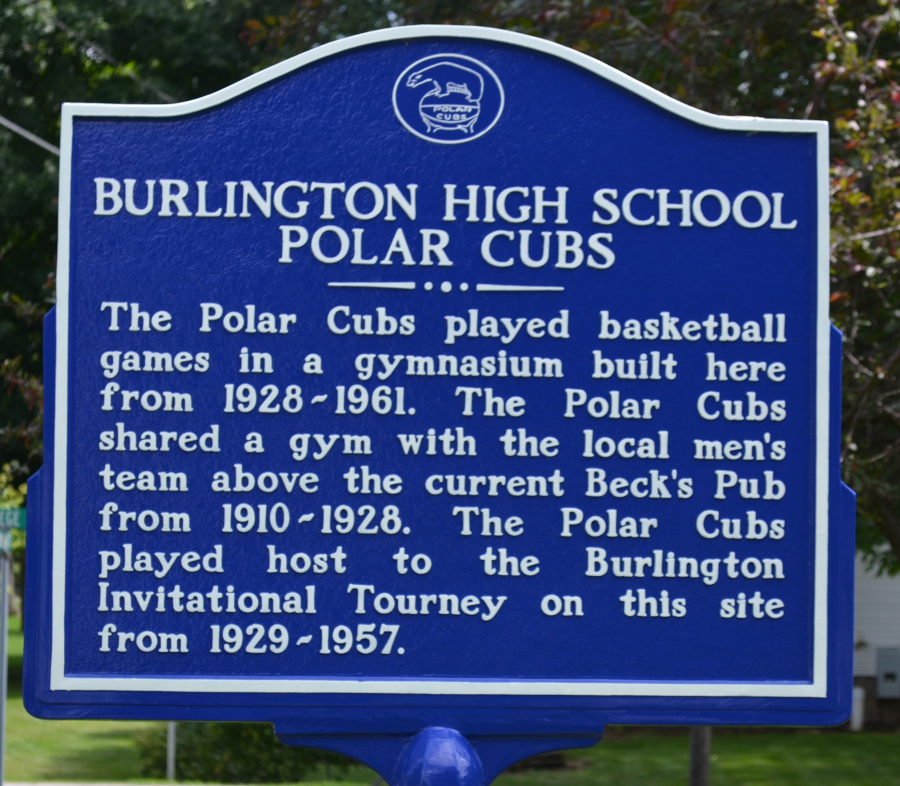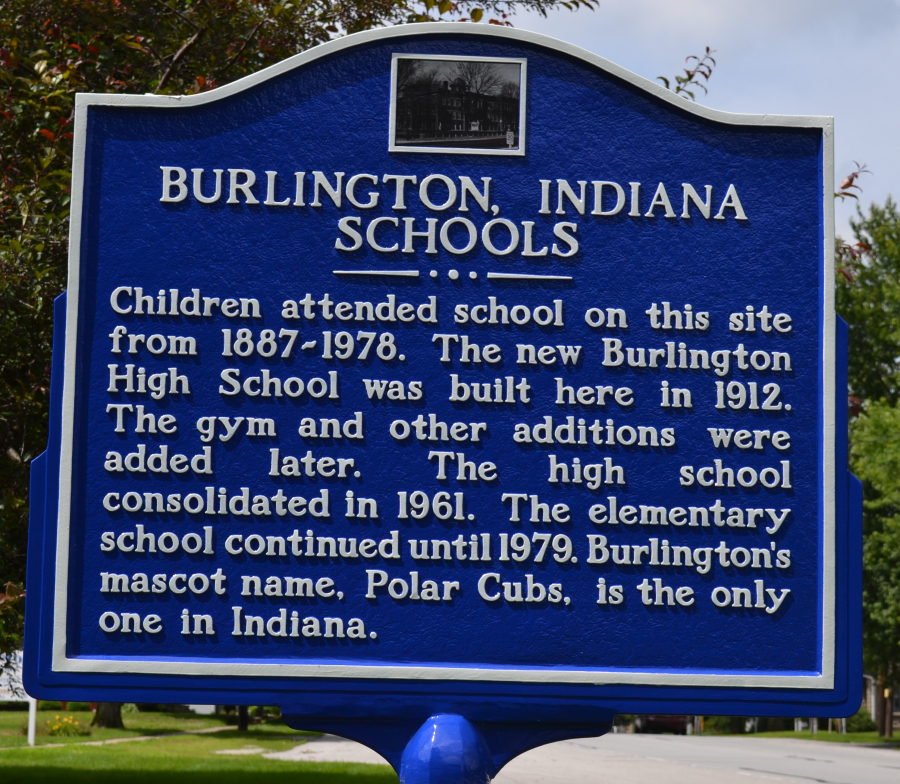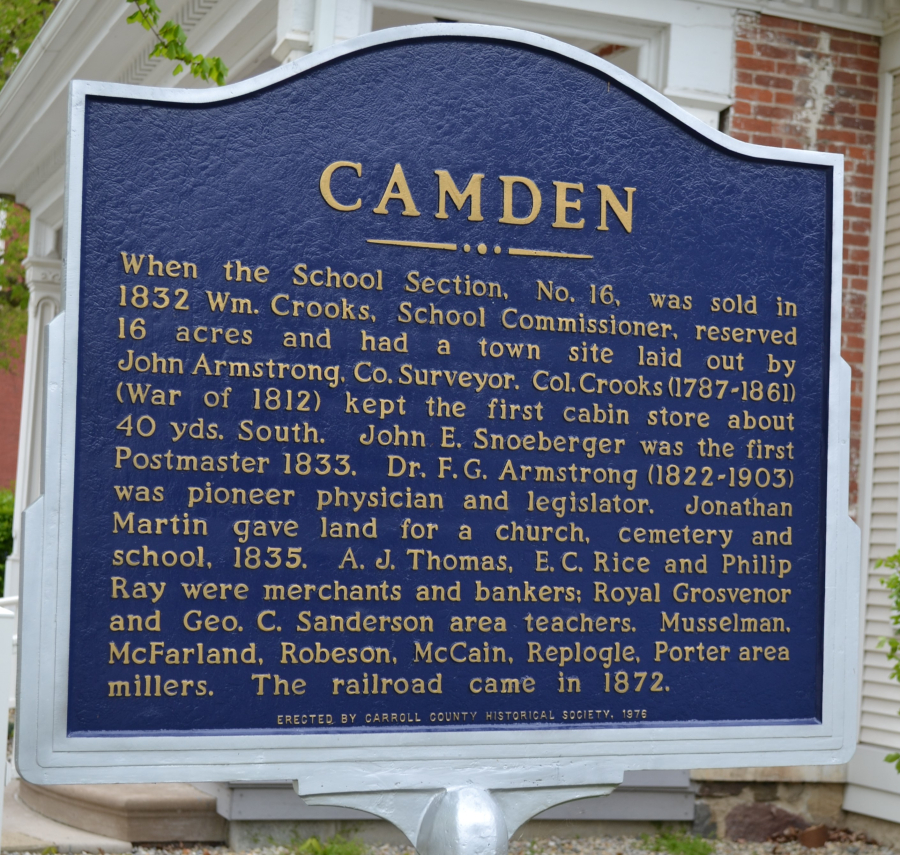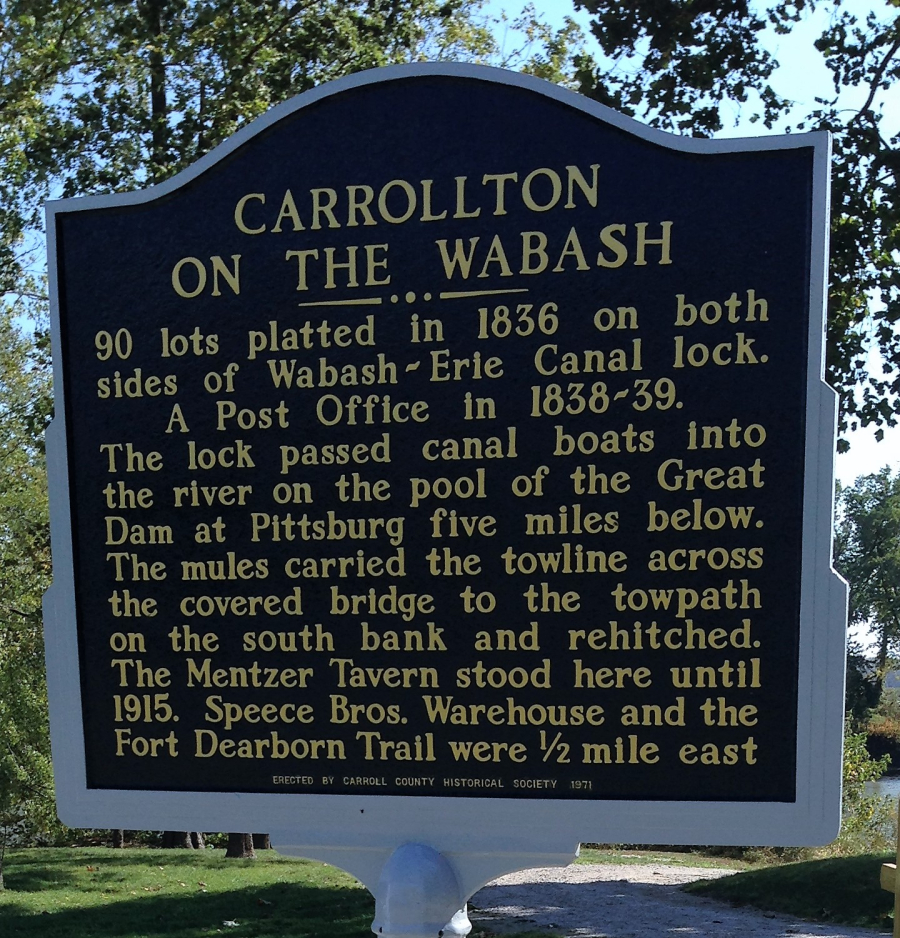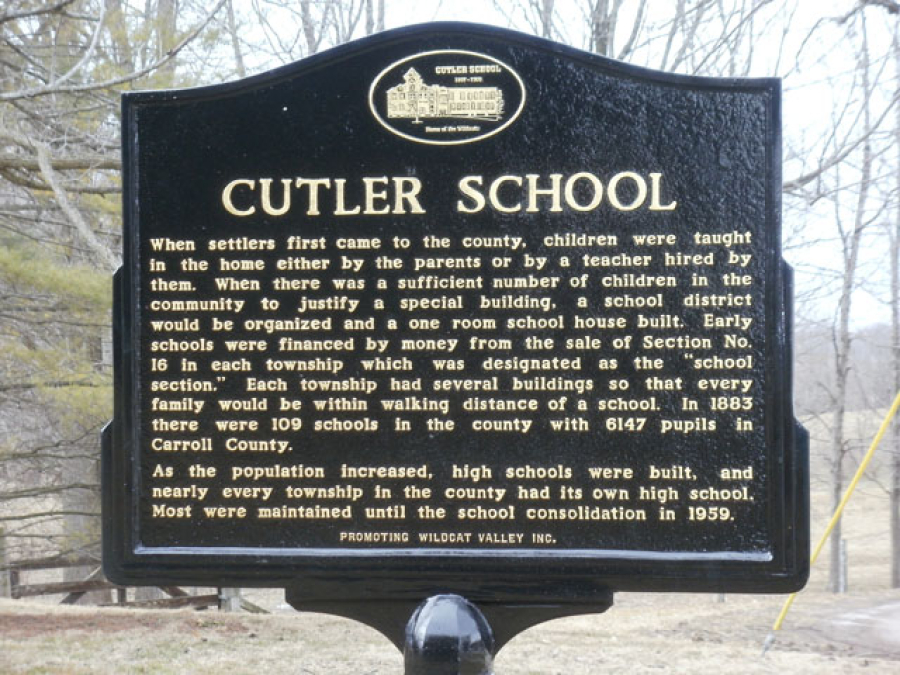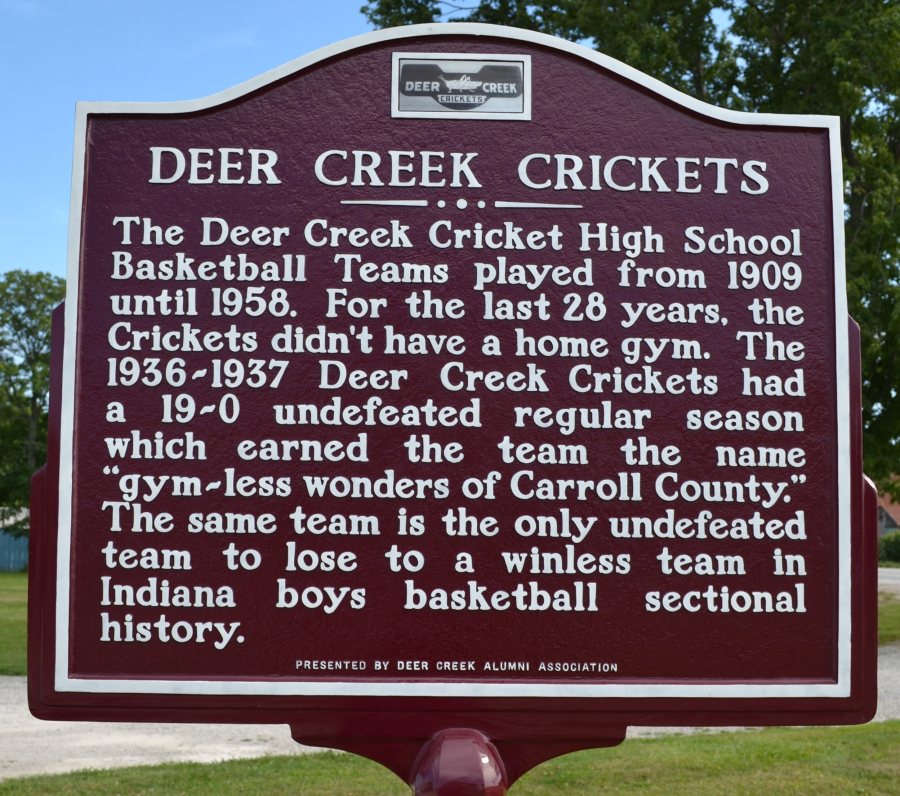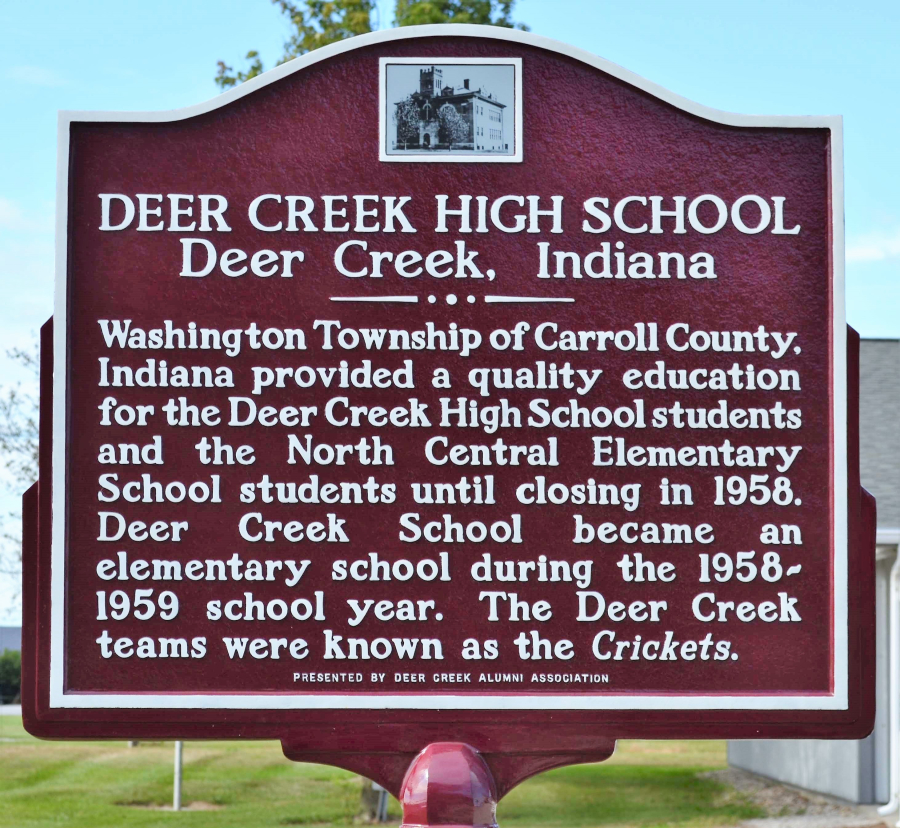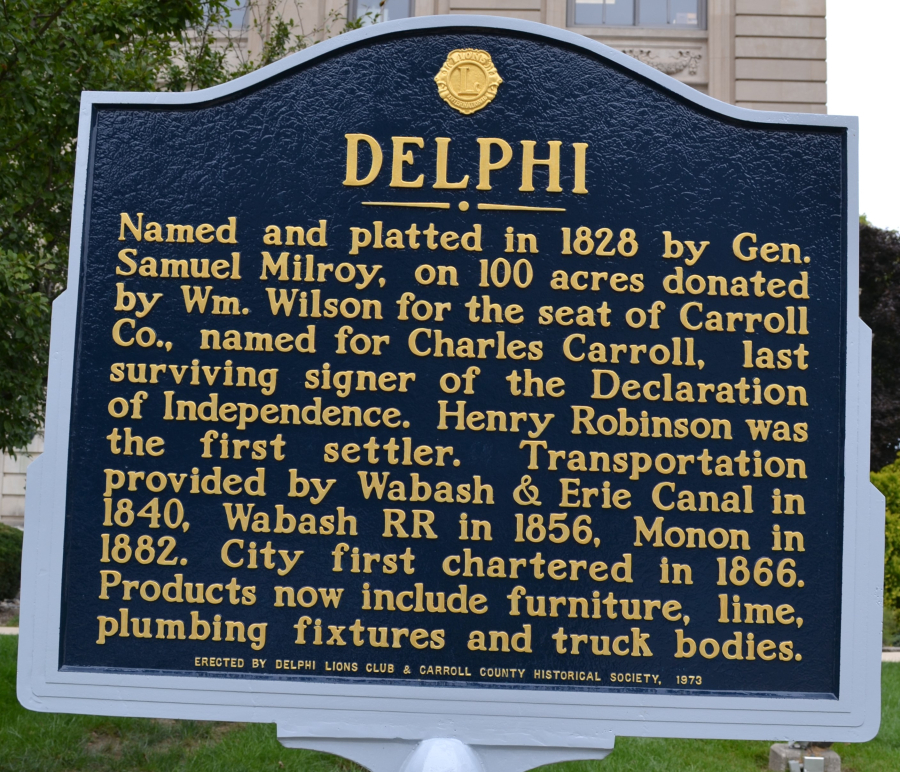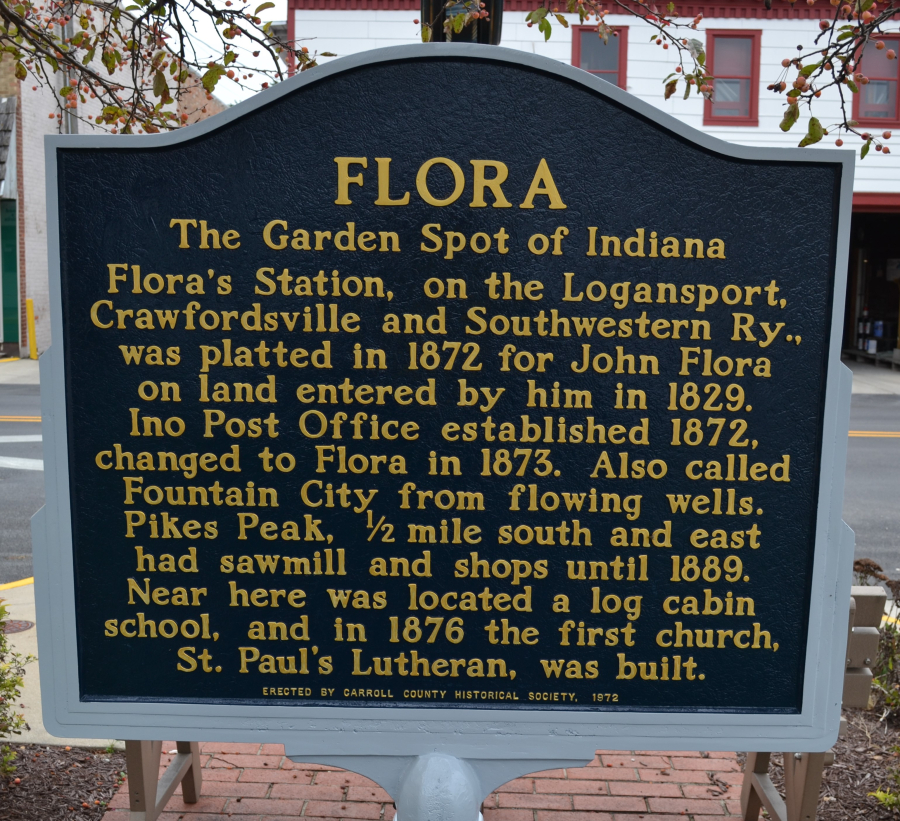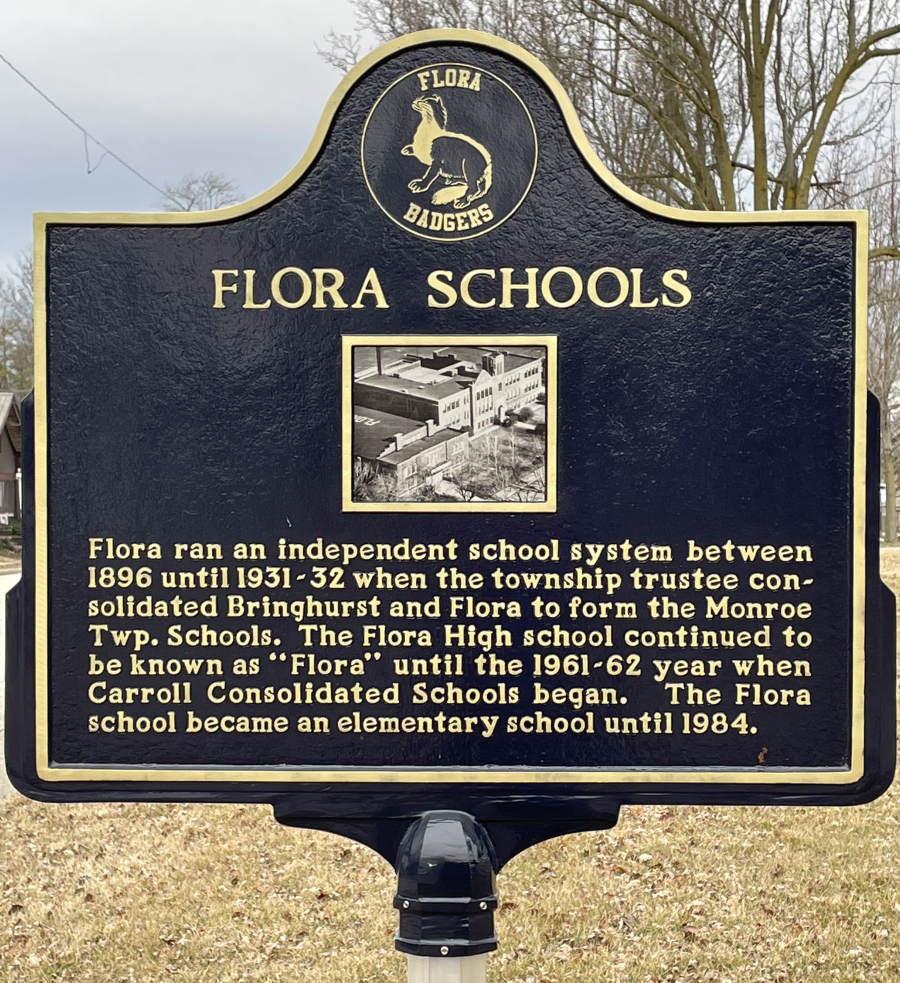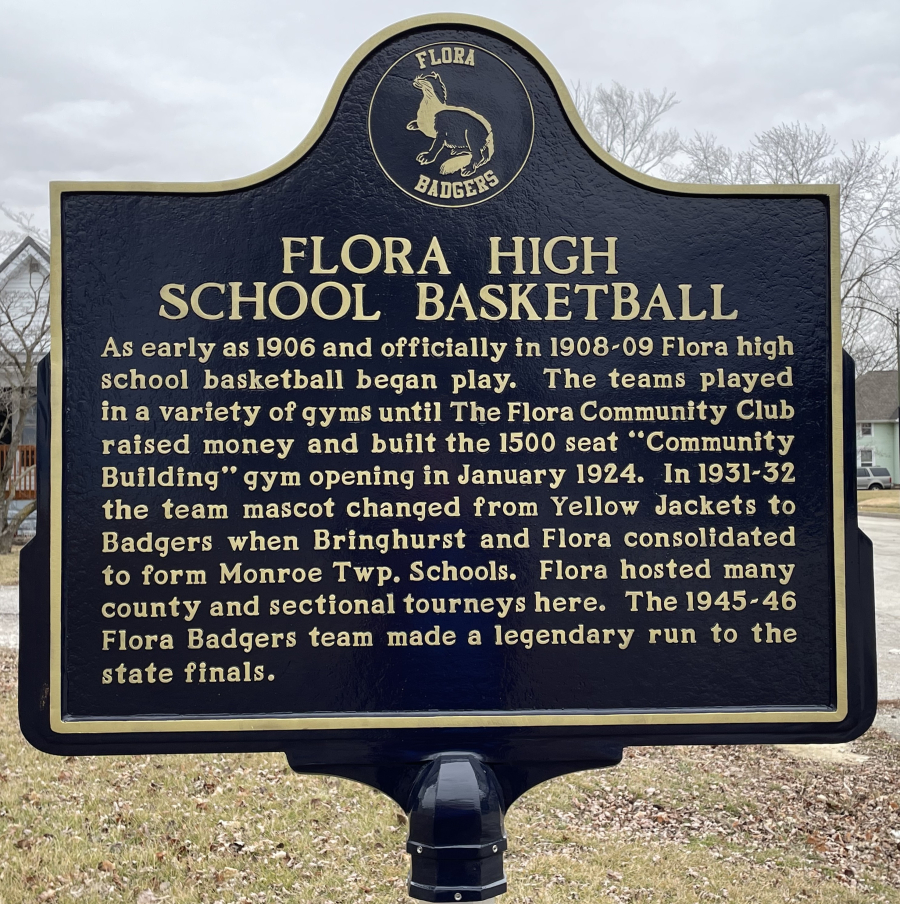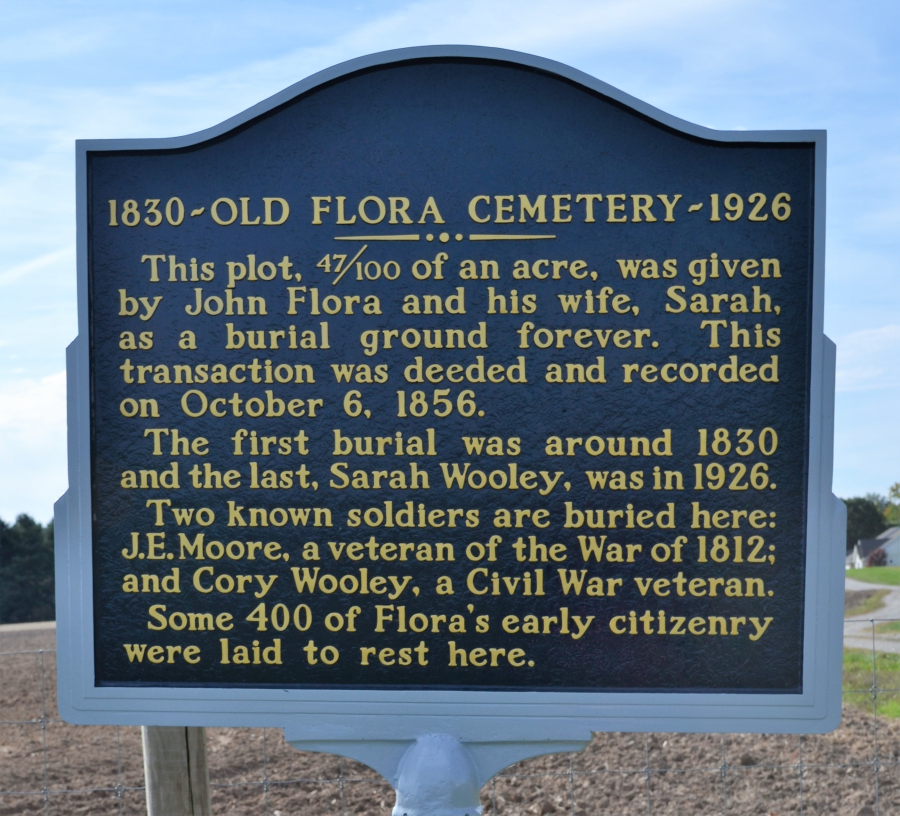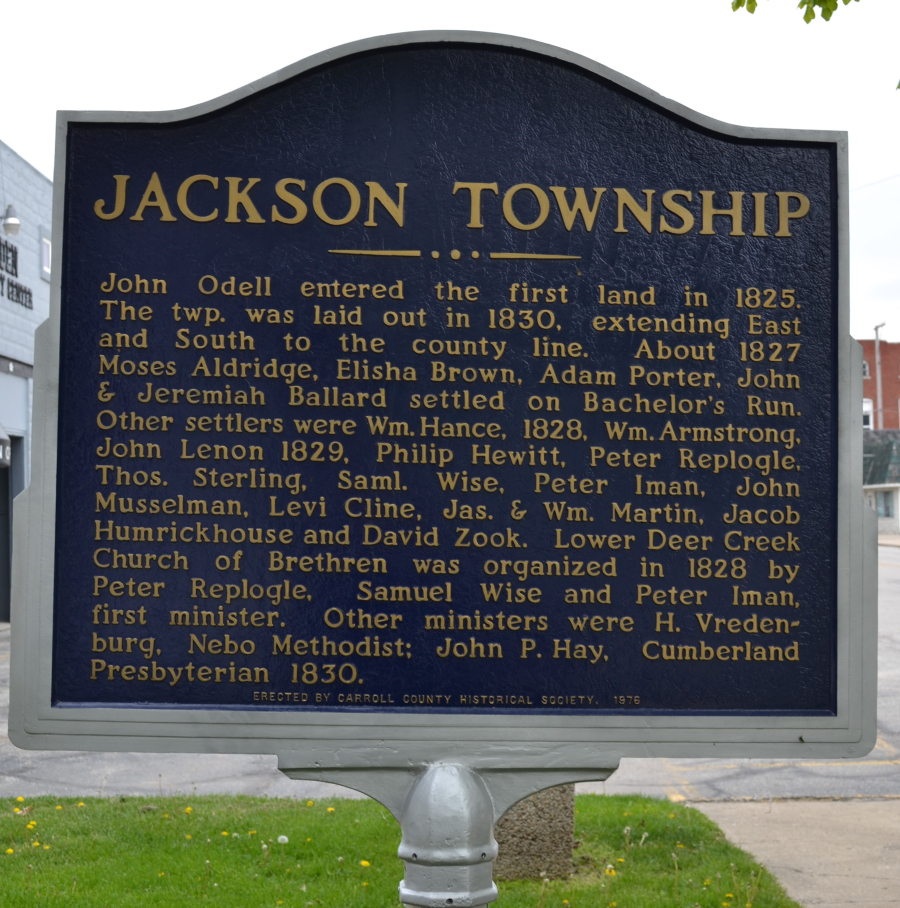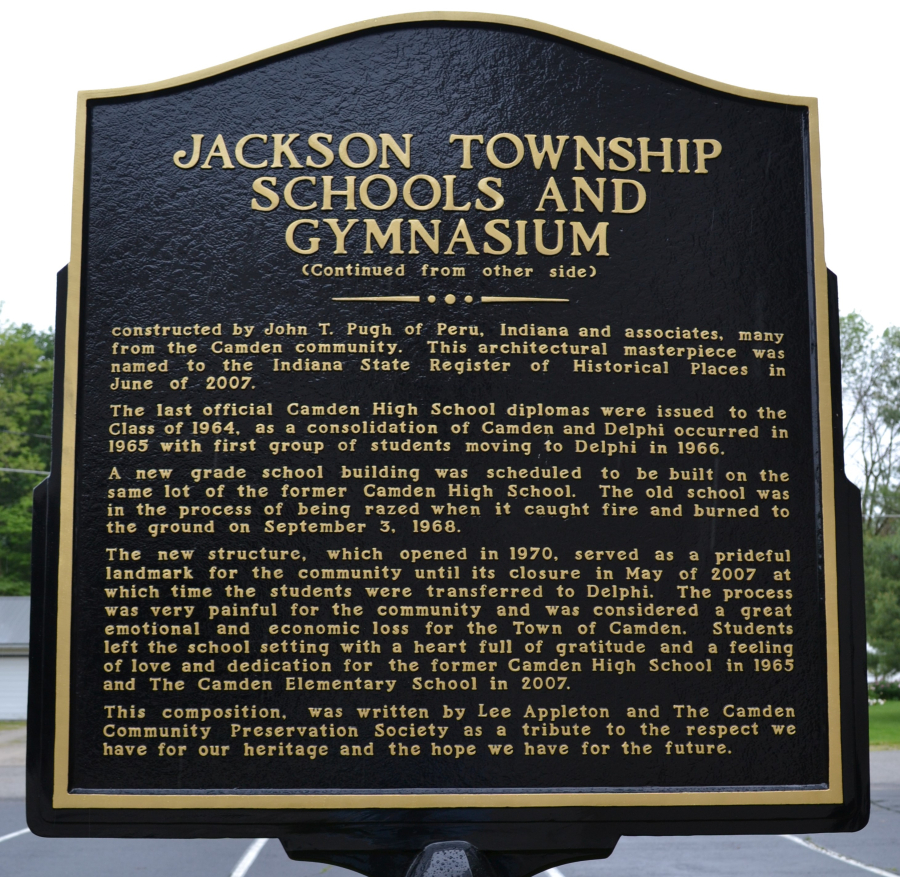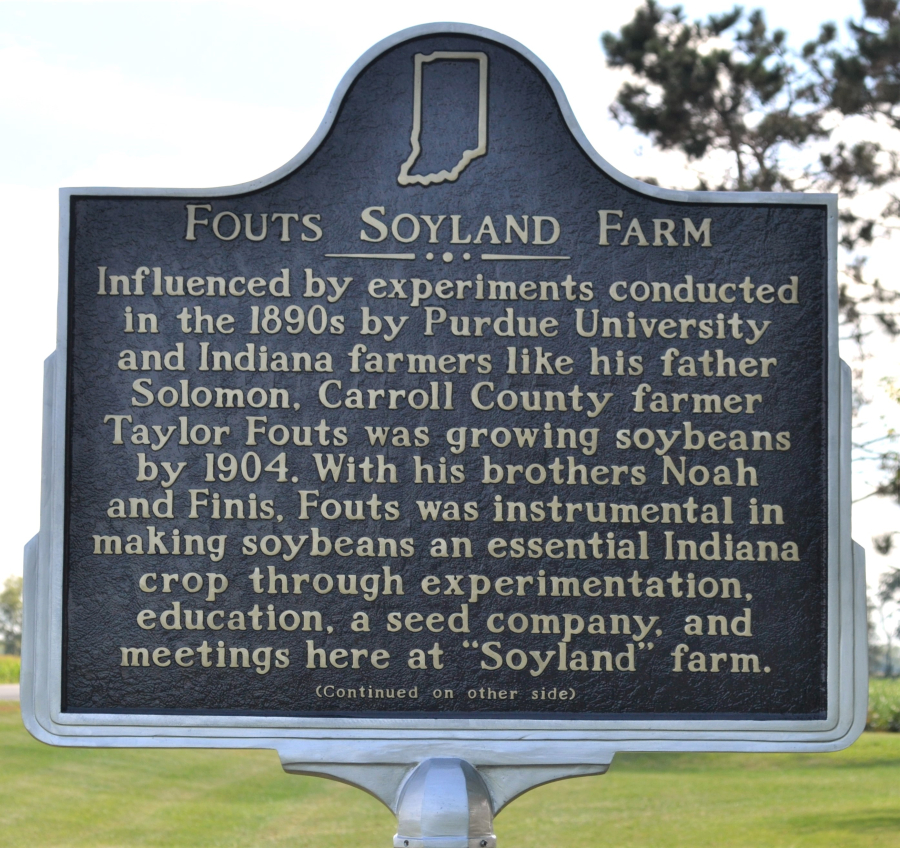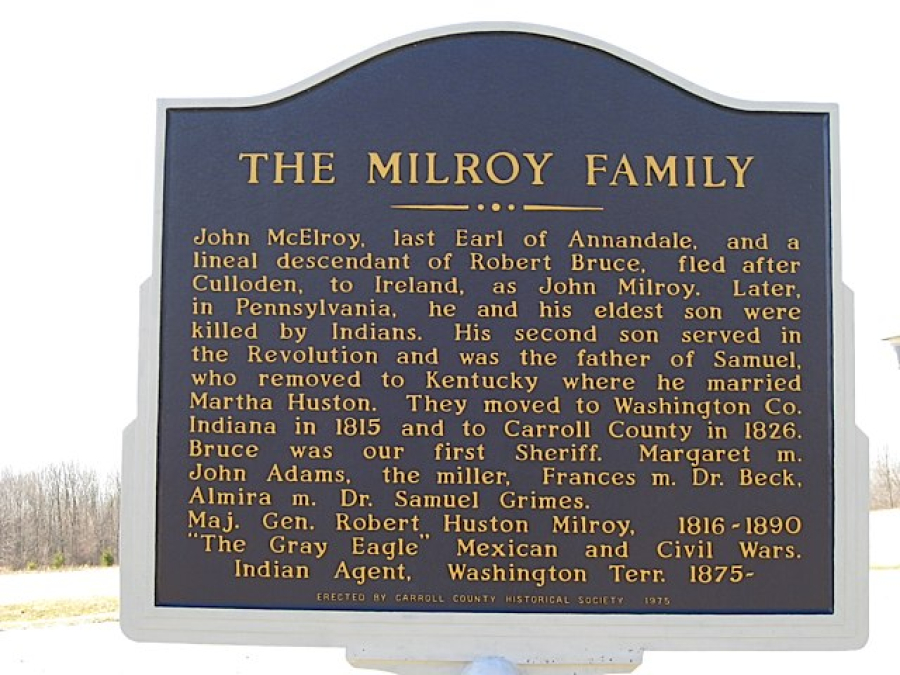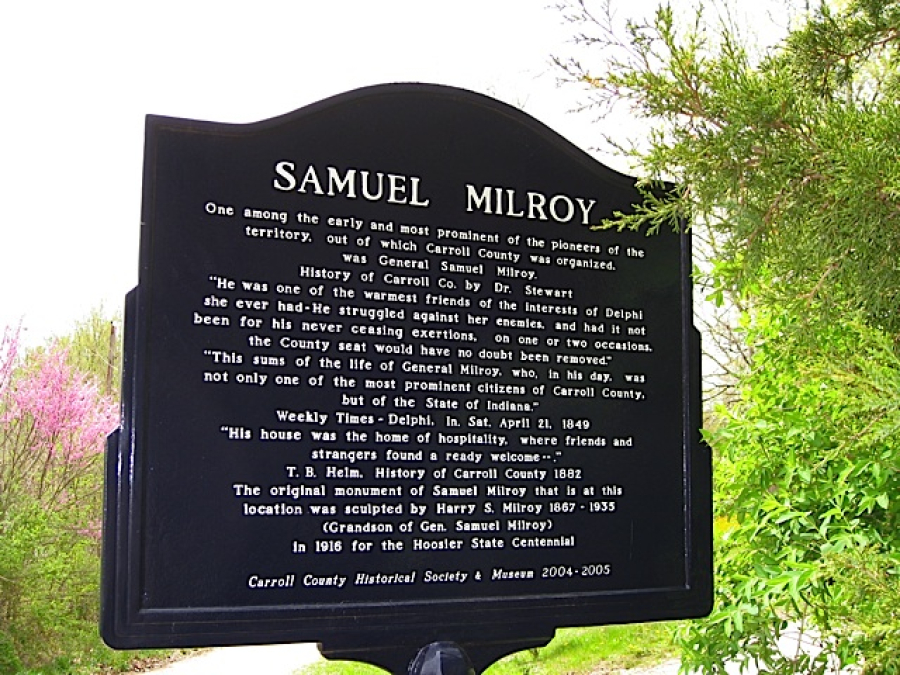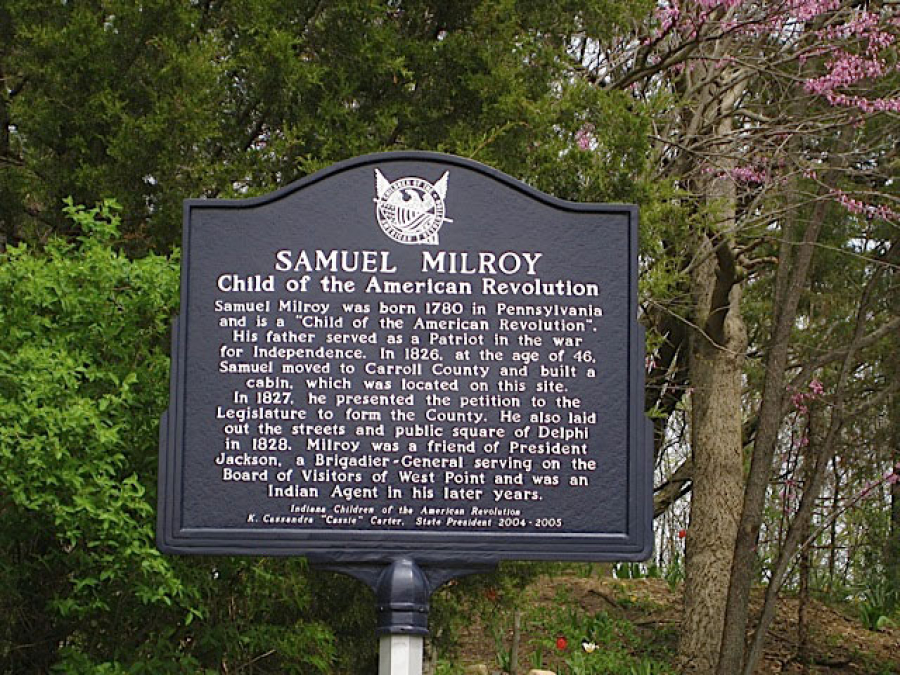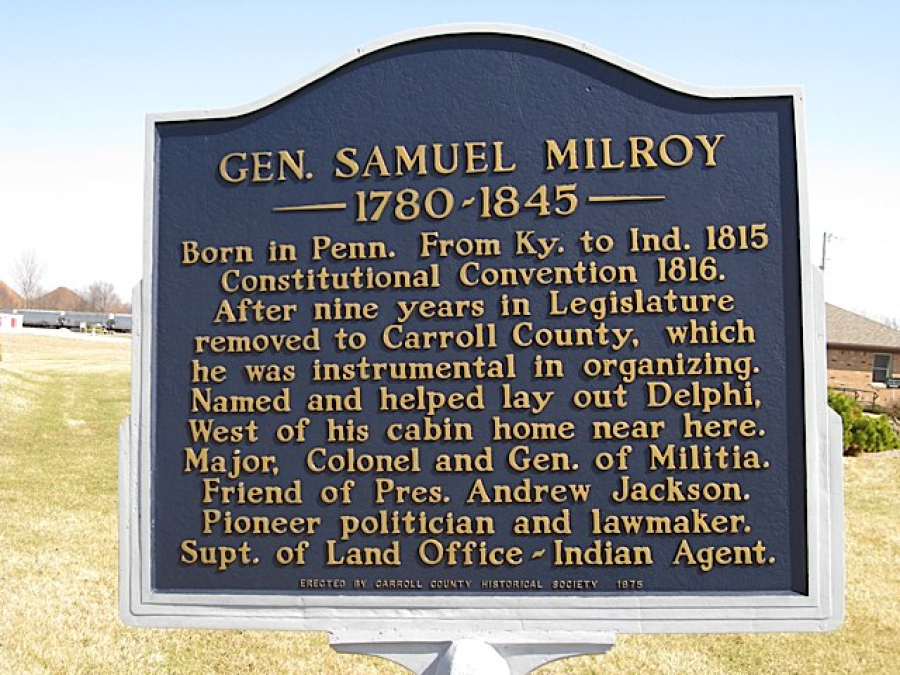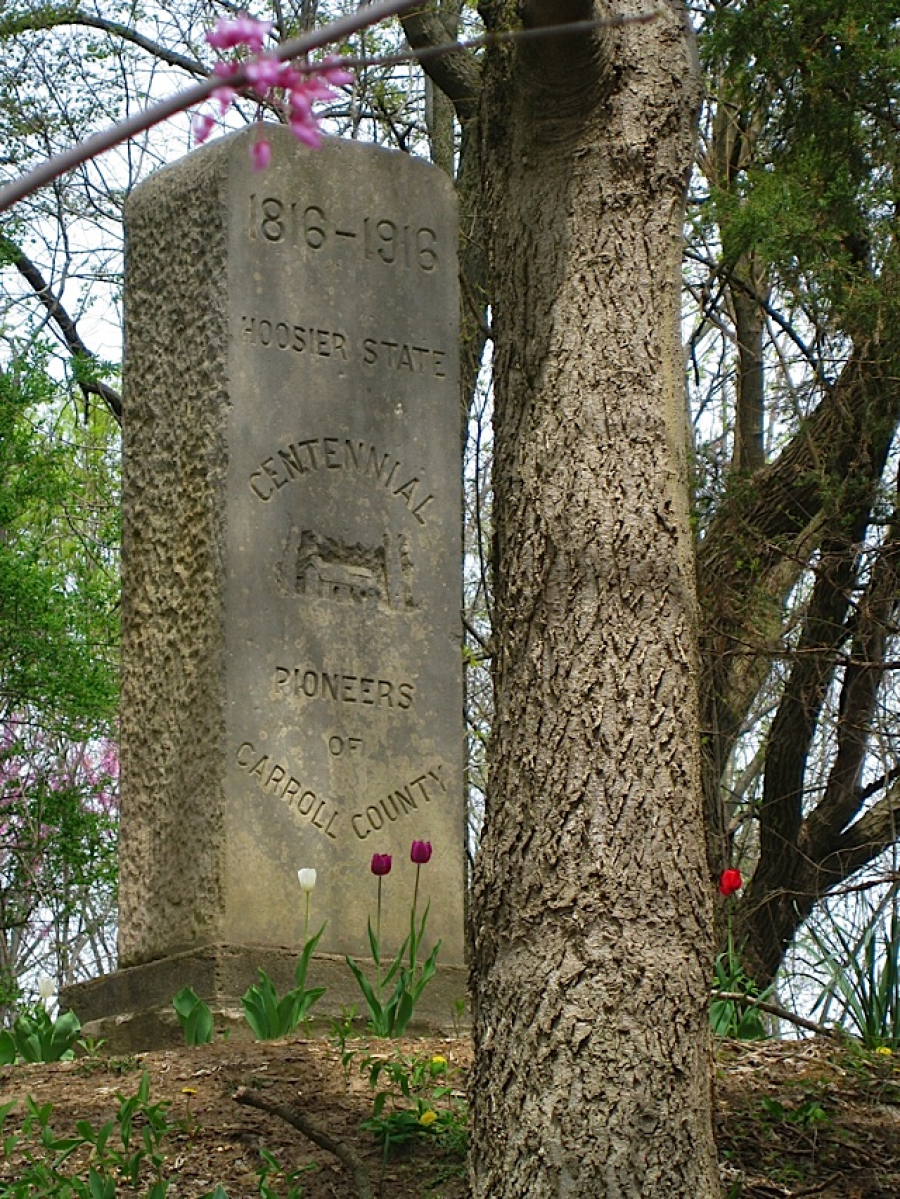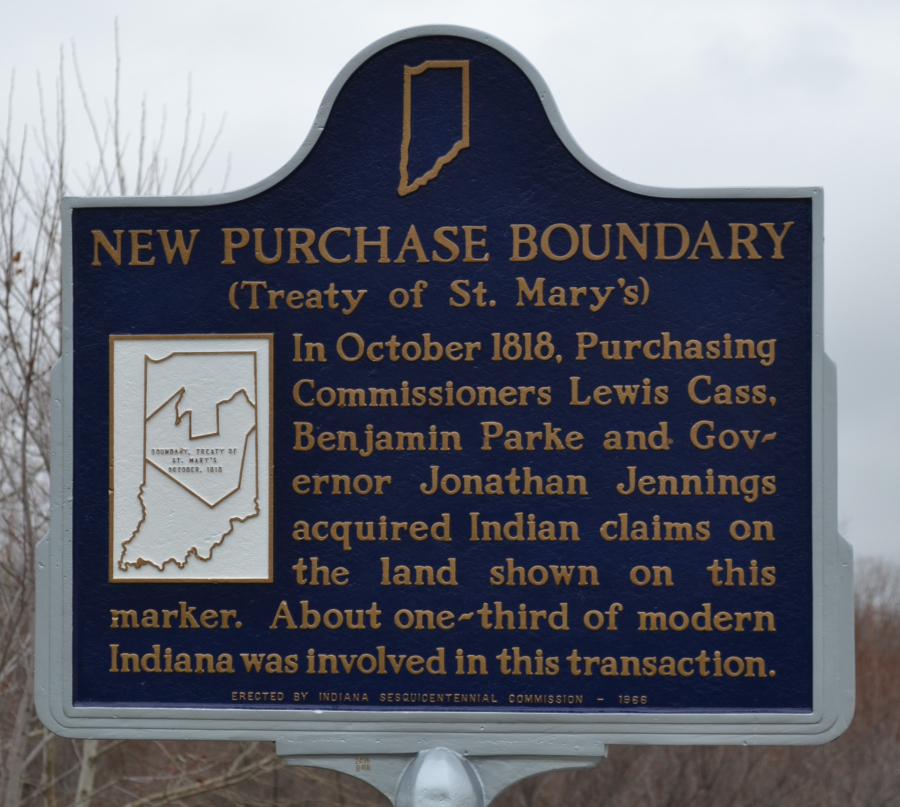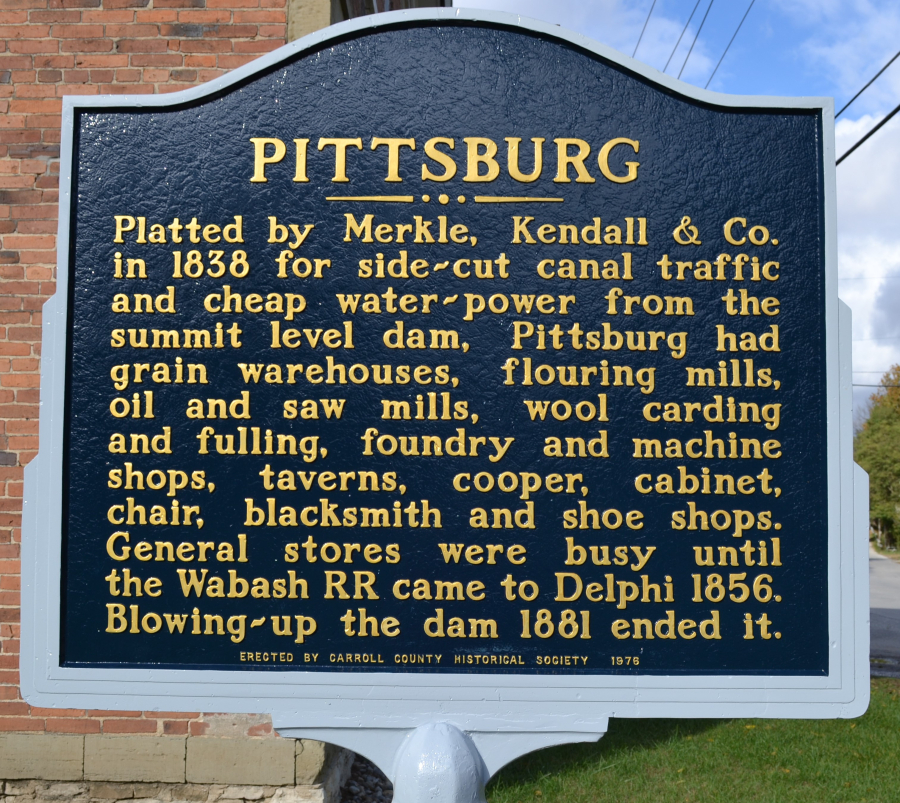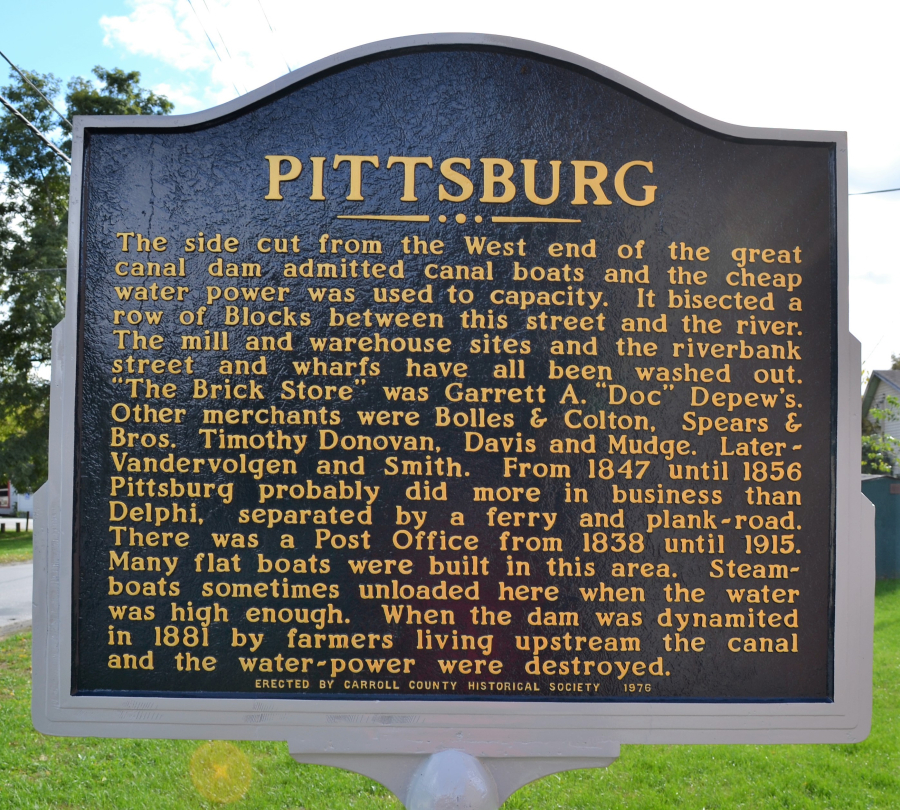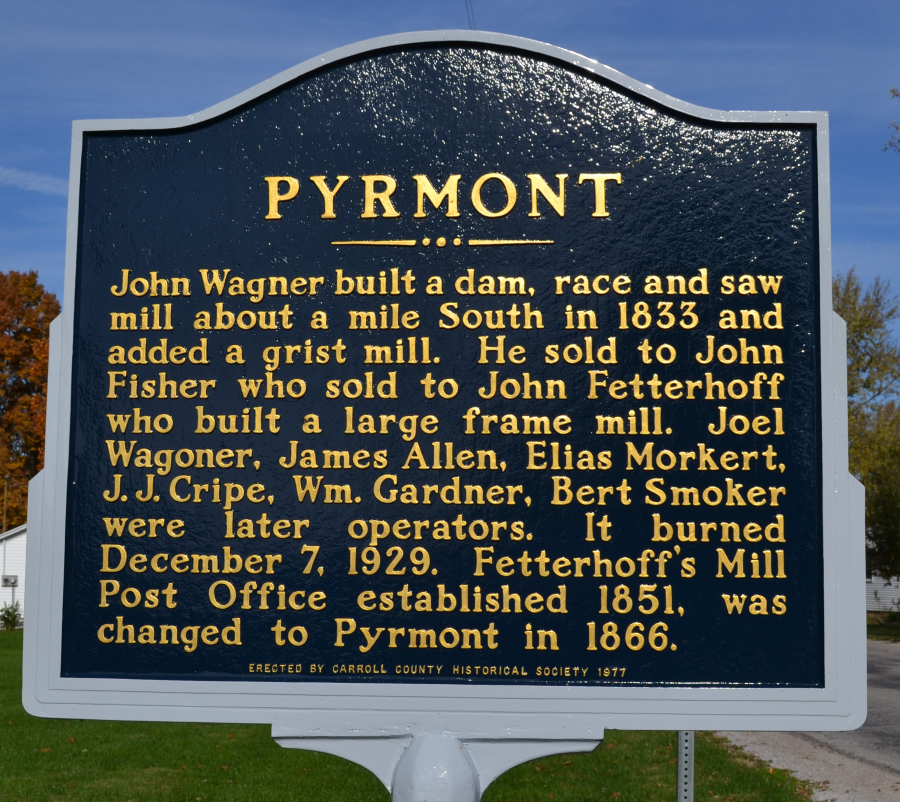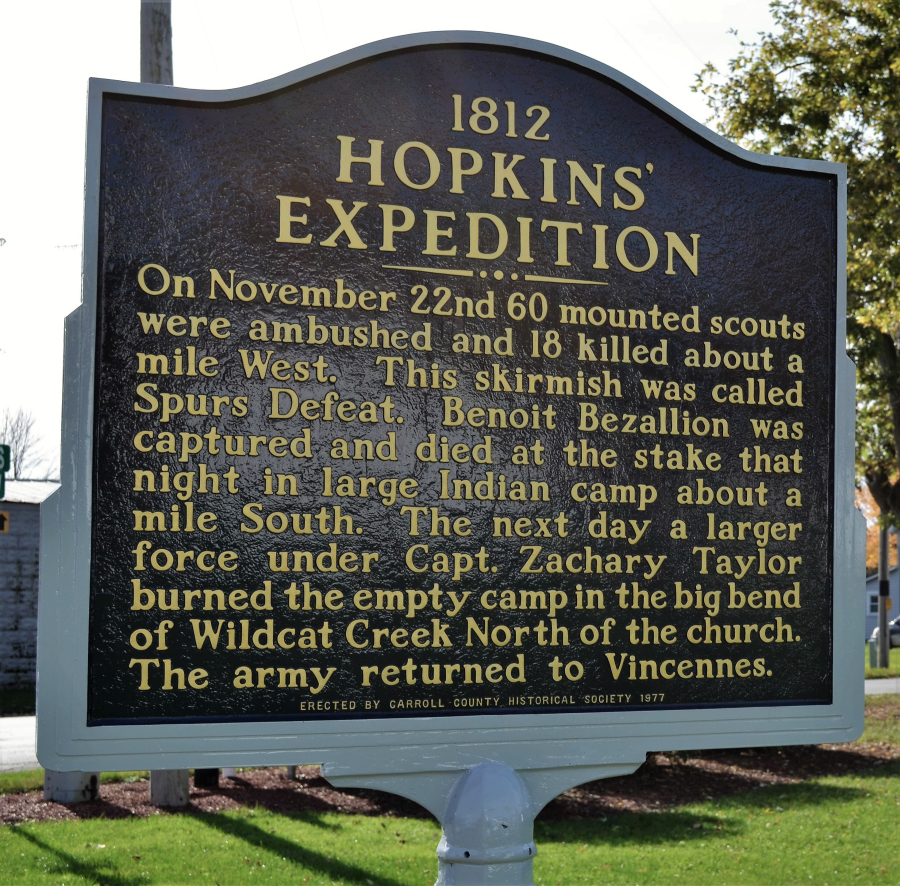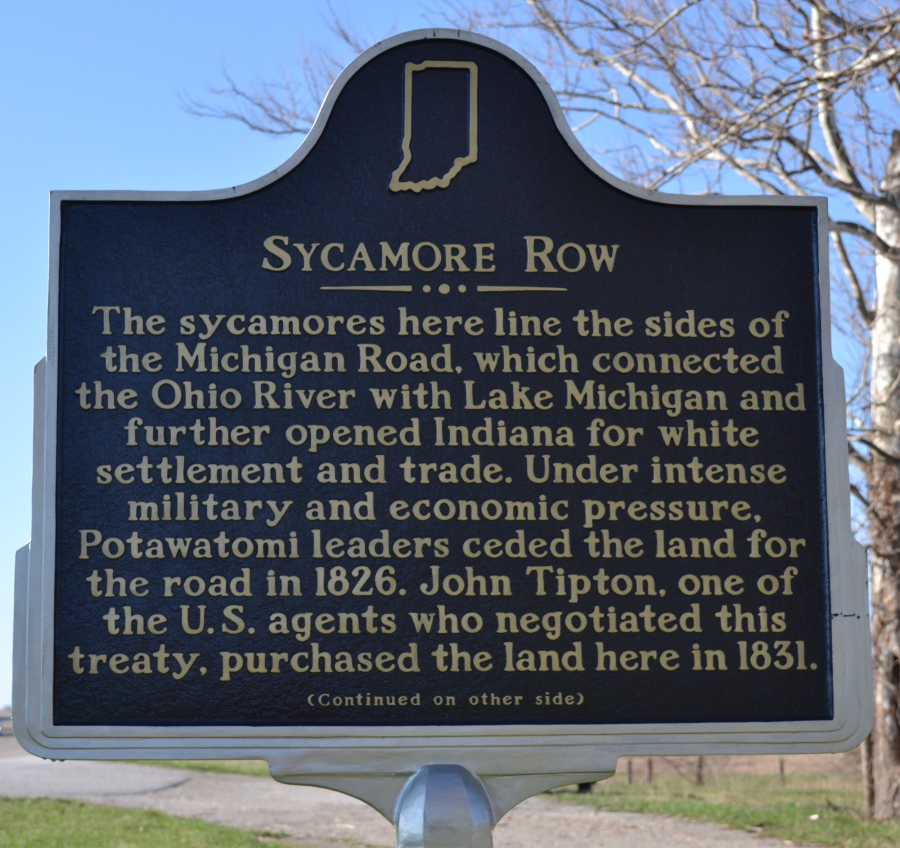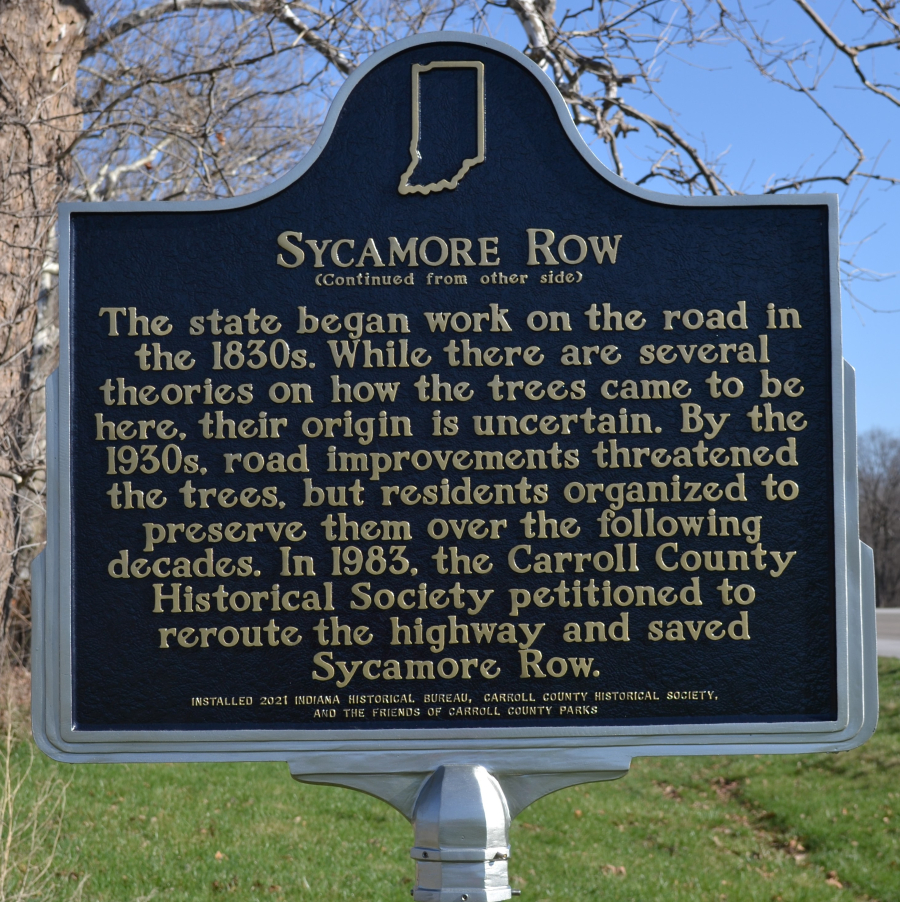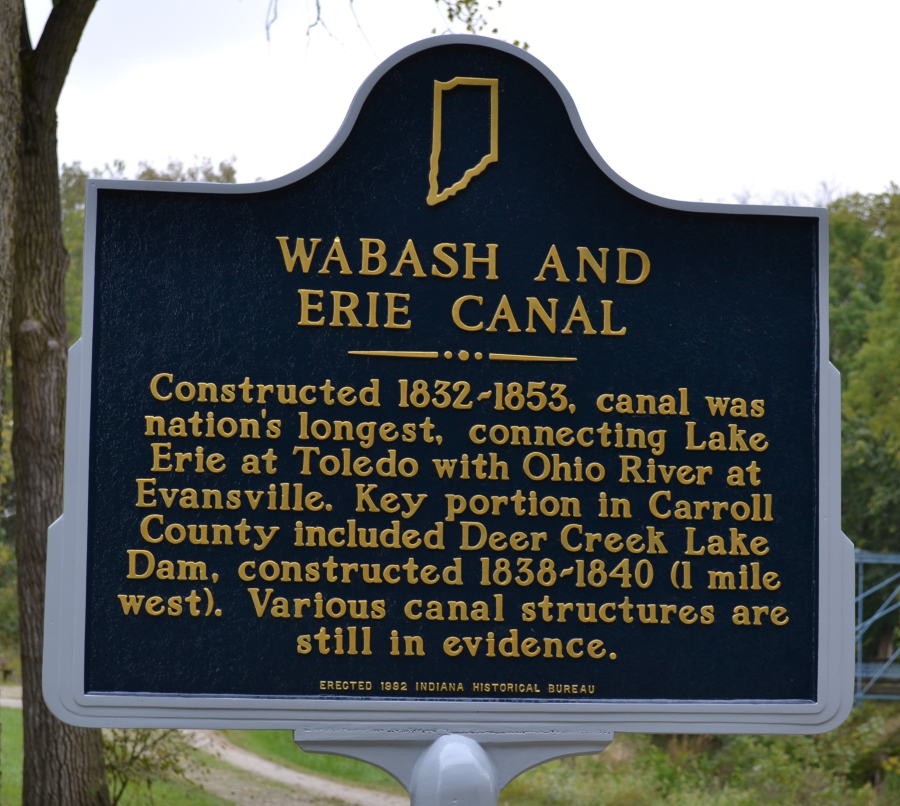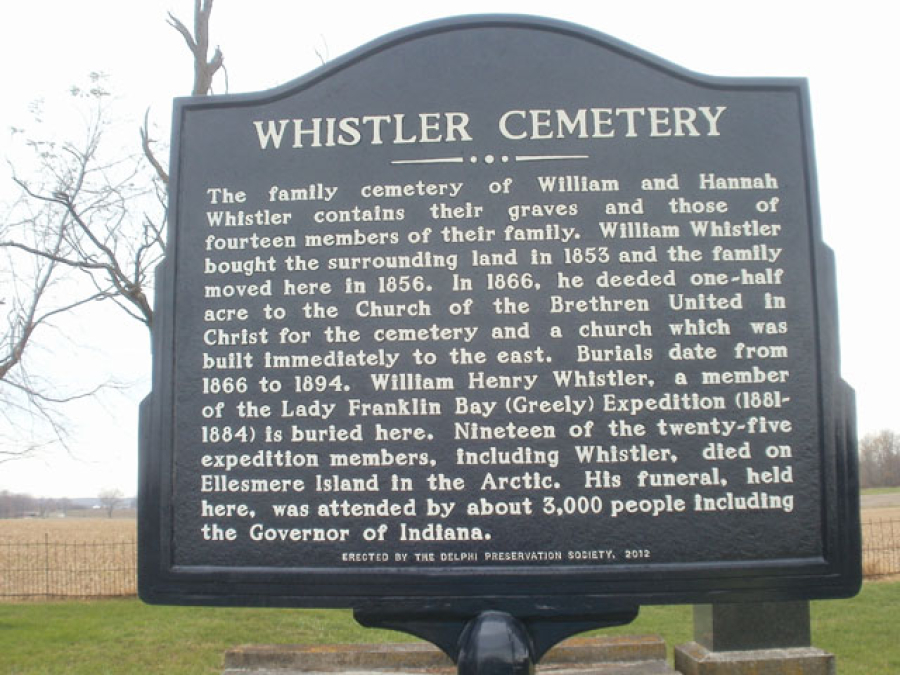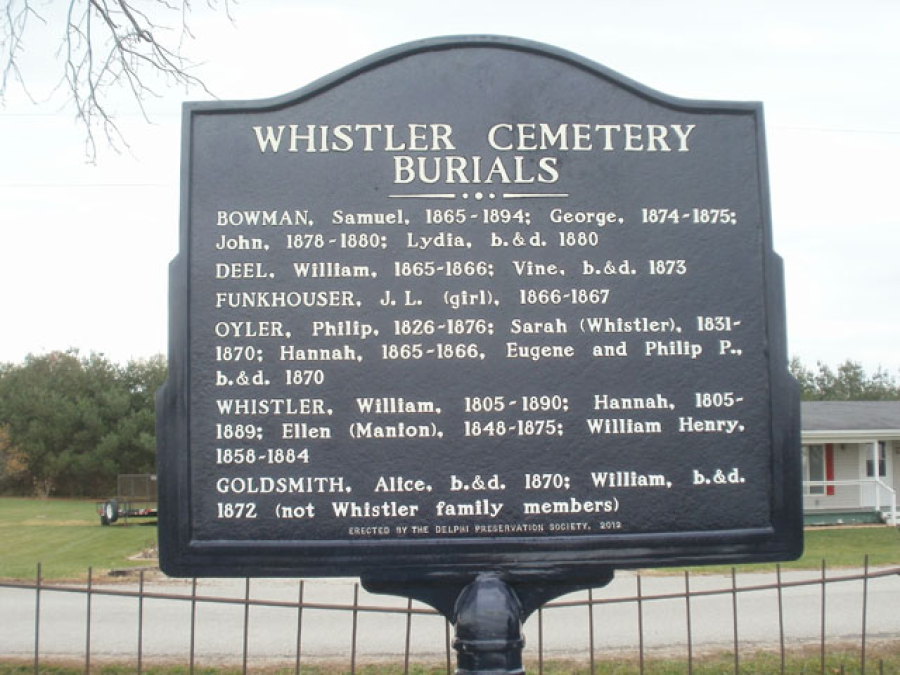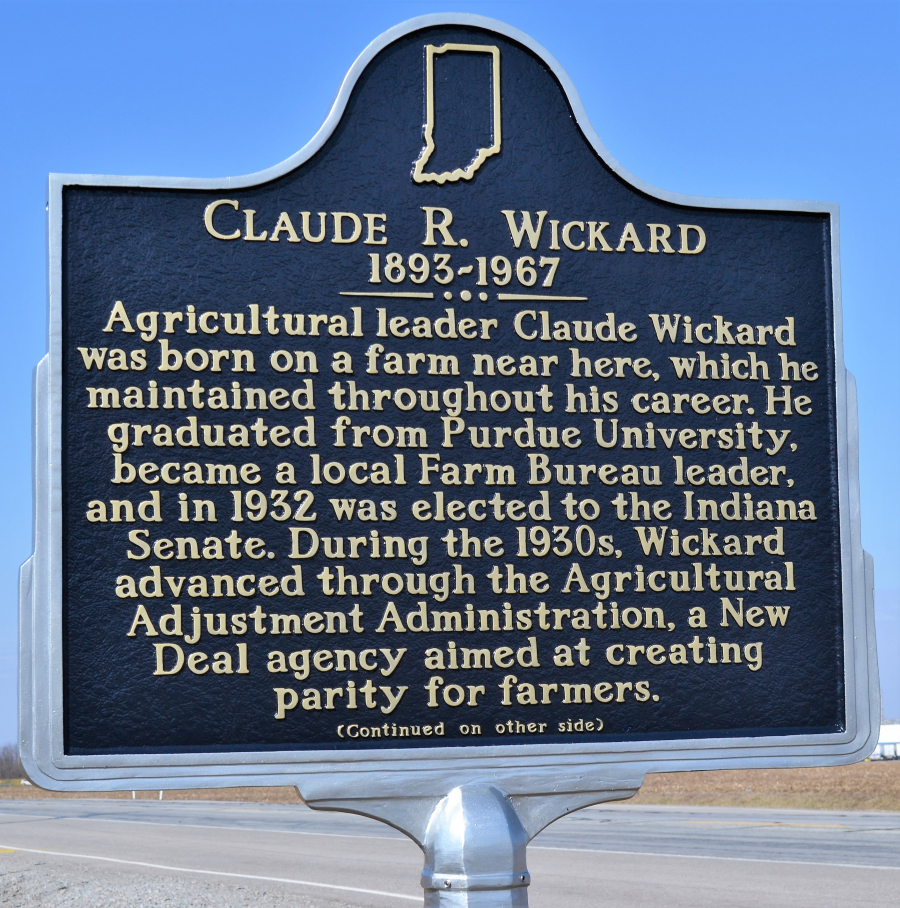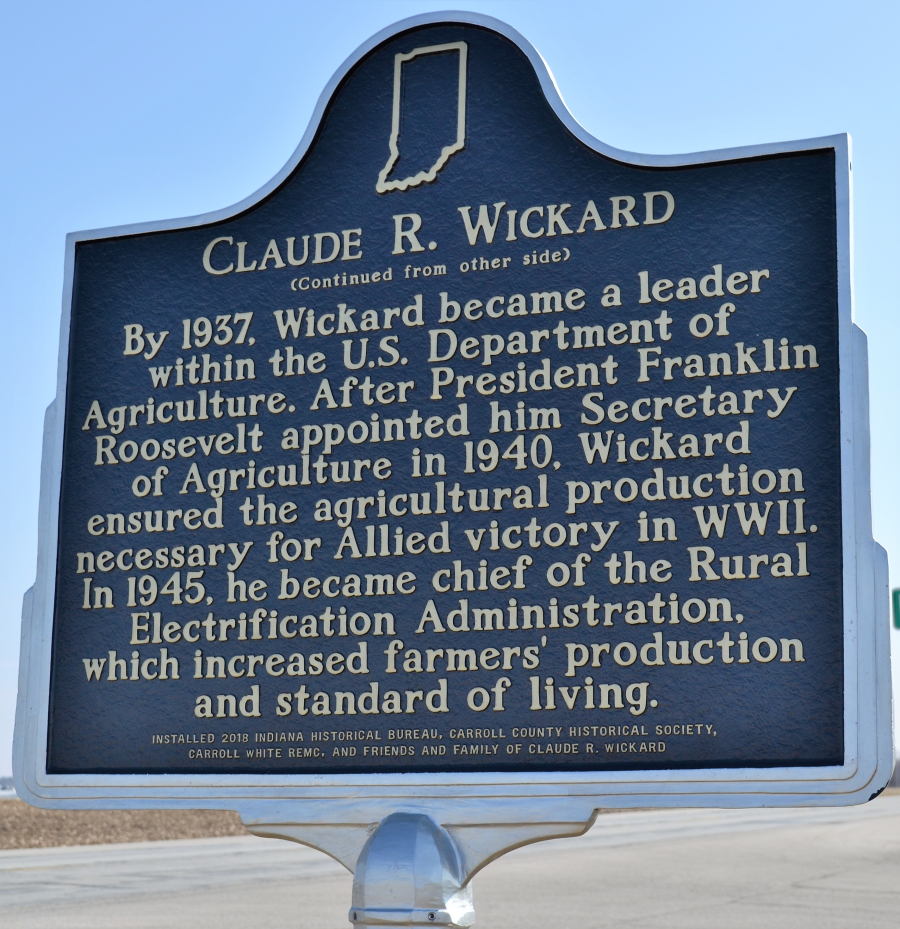Historical Markers in Carroll County
Some of Carroll County’s historic sites are marked with heavy metal markers that were installed as early as 1971. Some of these replaced markers that had been placed in 1936 in a state-wide program. Three of the signs are part of the Indiana Historical Bureau’s program, and the others were placed by the Carroll County Historical Society or other organizations.
Click on a title below to review the marker text and other information.
Adams Mill
Historical Marker Text
In 1831 John Adams, Pennsylvania, built a saw mill here. In 1832 he entered land. In 1835-36 added a flouring mill. The present building was erected in 1845, restored by Mr. & Mrs. Claude Sheets in 1940. Boliver Village was platted around the mill in 1837 and Wild Cat P.O., 1850-1894 was in the mill. Warren Adams ran the mill after 1861. Masonic lodge organized at the mill 1864. The covered bridge built 1872.
Erected by Questers of Carroll County at Adams Mill near Cutler.
American Soybean Association
Burlington
The Burlington sign was erected in Burlington at the junction of State Roads 29 and 22 in 1973.
Burlington High School Polar Cubs
Burlington, Indiana Schools
The Burlington High School two-sided sign was erected by promoting the Wildcat Valley.
Camden
When the School Section, No. 16, was sold in 1832 Wm. Crooks, School Commissioner, reserved 16 acres and had a town site laid out by John Armstrong, Co. Surveyor. Col. Crooks (1787-1861) (War of 1812) kept the first cabin store about 40 yards South. John E. Snoeberger was the first Post Master 1833. Dr. F. G. Armstrong (1822-1903) was pioneer physician and legislator. Jonathan Martin gave land for a church, cemetery and school, 1835. A. J. Thomas, E. C. Rice and Philip Ray were merchants and bankers; Royal Grosvenor and Geo. C. Sanderson area teachers. Musselman, McFarland, Robeson, McCain, Replogle, Porteer area millers. The railroad came in 1872.
Carrollton on the Wabash
90 lots, platted in 1836 on both sides of Wabash-Erie Canal lock. A Post Office in 1838-39. The lock passed canal boats into the river on the pool of the Great Dam at Pittsburg five miles below. The mules carried the towline across the covered bridge to the towpath on the south bank and rehitched. The Mentzer Tavern stood there until 1915. Speece Bros. Warehouse and the Fort Dearborn Trail were ½ mile east.
The first Historical marker erected by the Carroll County Historical Society was placed at the North end of the Carrollton Bridge in 1971. It was re-set near the bridge after the bridge’s recent renovation.
Cutler School
Historical Marker Text
When settlers first came to the county children were taught in the home either by the parents or by a teacher hired by them. When there was a sufficient number of children in the community to justify a special building, a school district would be organized and a one room school house built. Early schools were financed by money from the sale of Section No. 16 in each township which was designated as the “school section.” Each township had several buildings so that every family would be within walking distance of a school. In 1883 there were 109 schools in the county with 6147 pupils in Carroll County. As the population increased, high schools were built, and nearly every township in the county had its own high school. Most were maintained until the school consolidation in 1959.
Erected in 2012 by Promoting Wildcat Valley.
Deer Creek Crickets
Deer Creek High School, Deer Creek, Indiana
Washington Township of Carroll County, Indiana provided a quality education for the Deer Creek High School students until closing in 1958. Deer Creek School became an elementary school during the 1958-1959 school year. The Deer Creek teams were known as the Crickets.
The Deer Creek marker was presented by the Deer Creek Alumni Association.
Delphi
Named and platted in 1828 by Gen. Samuel Milroy, on 100 acres donated by Wm. Wilson for the seat of Carroll Co., named for Charles Carroll, last surviving signer of the Declaration of Independence. Henry Robinson was the first settler. Transportation provided by Wabash & Erie Canal in 1840, Wabash RR in 1856, Monon in 1882. City first chartered in 1866. Products now include furniture, lime, plumbing fixtures and truck bodies.
The Delphi sign was erected on the south side of the Courthouse in 1973 by the Delphi Lions Club and the Carroll County Historical Society.
Flora
The Garden Spot of Indiana. Flora’s Station, on the Logansport, Crawfordsville and Southwestern Ry., was planned in 1872 for John Flora on land entered by him in 1829. Ino Post Office established 1872, changed to Flora in 1873. Also called Fountain City from flowing wells. Pikes Peak, ½ mile South and East had sawmill and shops until 1889. Near here was located a log cabin school, and in 1876 the first church, St. Paul’s Lutheran, was built.
The Flora sign in the Flora City Parking Lot was erected in 1972 as a part of the Flora Centennial program.
Fouts Soyland Farm
Jackson Township
John Odell entered the first land in 1825. The twp. was laid out in 1830, extending East and South to the county line. About 1827 Moses Aldridge, Elisha Brown, Adam Porter, John & Jeremiah Ballard settled on Bachelor’s Run. Other settlers were Wm. Hance, 1828, Wm. Armstrong, John Lenon 1829, Philip Hewitt, Peter Replogle, Thos. Sterling, Saml. Wise, Peter Iman, John Musselman, Levi Cline, Jas. & Wm. Martin, Jacob Humrickhouse and David Zook. Lower Deer Creek Church of Brethren was organized in 1828 by Peter Replogle, Samuel Wise and Peter Iman, first minister. Other ministers were H. Vredenburg, Nebo Methodist; John P. Hay, Cumberland Presbyterian 1830.
The two-paneled Jackson Township and Camden sign was erected at the Camden Library in 1977.
Jackson Township Schools & Gymnasium
As Camden grew in size it became necessary to have an even bigger school. The land on which it was built was secured from Dr. Franklin P. Armstrong, a former State Senator. A four room brick structure was erected in 1872 on the yard west of the present school building, which is now known as the Camden Early Childhood Center as of May 2007.
In 1895 when W.W. Allison became trustee, the condition of the 1872 school building was becoming a concern. This issue caused Mr. Allison and the board to construct the beautiful former Camden High School of which Camden was and still is, in memory only, justly proud, at the cost of $18,000. The building was built on the same lot and opened in 1899.
In 1920 it became necessary to add on another section to the school including a gymnasium, built nearly ten feet below ground, with a second floor containing classrooms and administration offices.
On September 18, 1951, bids were opened for a new gymnasium in Camden with the cost submitted of $122,000. For the time period it was considered to be state of the art composition. It was constructed by John T. Pugh of Peru, Indiana and associates, many from the Camden community. This architectural masterpiece was named to the Indiana State Register of Historical Places in June of 2007.
The last official Camden High School diplomas were issued to the Class of 1964, as a consolidation of Camden and Delphi occurred in 1965 with first group of students moving to Delphi in 1966. A new grade school building was scheduled to the built on the same lot of the former Camden High School. The old school was in the process of being razed when it caught fire and burned to the ground on September 3, 1968.
The new structure, which opened in 1970, served as a prideful landmark for the community until its closure in May of 2007 at which time the students were transferred to Delphi. The process was very painful for the community and was considered a great emotional and economic loss for the Town of Camden. Students left the school setting with a heart full of gratitude and a feeling of love and dedication for the former Camden High School in 1965 and The Camden Elementary School in 2007.
This composition was written by Lee Appleton and The Camden Community Preservation Society as a tribute to the respect we have for our heritage and the hope we have for the future.
Milroy Family
John McElroy, last Earl of Annandale, and a lineal descendant of Robert Bruce, fled after Cullodan, to Ireland, as John Milroy. Later in Pennsylvania, he and his eldest son were killed by Indians. His second son served in the Revolution and was the father of Samuel, who removed to Kentucky where he married Martha Huston. They moved to Washington Co., Indiana in 1815 and to Carroll County in 1826. Bruce was our 1st Sheriff. Margaret m. John Adams, the miller. Frances m. Dr. Beck, Elmira m. Dr. Samuel Grimes.
Maj. Gen. Robert Huston Milroy 1816-1890. “The Gray Eagle” Mexican & Civil Wars. Indian Agent, Washington Terr. 1875.
Milroy, General Samuel 1780-1845
Born in Penn. From Ky. to Ind. 1815. Constitutional Convention 1816. After nine years in Legislature removed to Carroll County, which he was instrumental in organizing. Named and helped lay out Delphi, West of his cabin home near here. Major, Colonel & Gen. of Militia. Friend of Pres. Andrew Jackson. Pioneer politician and lawmaker. Supt. of Land Office-Indian Agent.
This two-sided sign was erected east of Delphi near County Road 300N in 1975, giving a brief history of Gen. Samuel Milroy and the Milroy family.
Milroy, Samuel
One among the early and most prominent of the pioneers of the territory, out of which Carroll County was organized, was General Samuel Milroy. (History of Carroll Co. by Dr. Stewart)
"He was one fo the warmest friends of the interests of Delphi she ever had. He struggled against her enemies, and had it not been for his never ceasing exertions, on one or two occasions, the County seat would have no doubt been removed."
"This sums up the life of General Milroy, who, in his day, was not only one of the most prominent citizens of Carroll County but of the State of Indiana.": (Weekly Times - Delphi, In., Sat. April 21, 1849.)
"His house was the home of hospitality, where friends and strangers found a ready welcome." (T.B. Helm, HIstory of Carroll County 1882.)
The original monument of Samuel Milroy that is at this location was scupted by Harry S. Milroy 1867-1935 (Grandson of Gen. Samuel Milroy) in 1916 for the Hoosier State Centennial.
Back side of above marker, Carroll County Historical Society & Museum 2004-2005. The sign is located off Old Camden Road in the eastern part of Delphi, adjacent to the stone monument marking the Milroy Cabin and on one of Delphi's Historic Trails.
Milroy, Samuel - Child of the Revolution
Samuel Milroy was born 1780 in Pennsylvania and is a "Child of the American Revolution." His father served as a Patriot in the war for Independence. In 1826, at the age of 46, Samuel moved to Carroll County and built a cabin, which was located on this site. In 1827, he presented the petition to the Legislature to form the County. He also laid out the streets and public square of Delphi in 1828. Milroy was a friend of President Jackson, a Brigadier-General serving on the Board of Visitors of West Point and was an Indian Agent in his later years.
Erected 2005 by Indiana Children of the American Revolution, K. Cassandra "Cassie" Carter, State President, 2004-2005.
New Purchase Boundary (Treaty of St. Mary's)
In October 1818, Purchasing Commissioners Lewis Cass, Benjamin Parke, and Governor Jonathan Jennings acquired Indian Claims on the land shown on this marker. About one-third of modern Indiana was involved in this transaction.
Erected by Indiana Sesquicentennial Commission 1966. Located east of the Wabash River bridge on Highway 421/39/18 between Pittsburg and Delphi.
Old Flora Cemetery, 1830-1926
This plot, 17/100 of an acre, was given by John Flora and his wife, Sarah, as a burial ground forever. This transaction was deeded and recorded on October 6, 1856. The first burial was around 1830 and teh last, Sarah Wooley, was in 1926. Two known soldiers are buried here: J.E. Moore, a veteran of the War of 1812; and Cory Wooley, a Civil War veteran. Some 400 of Flora's early citizenry were laid to rest here.
The Old Flora Cemetery and this marker are about .3 mile north of the old Flora school building, off a gravel road to the west.
Pittsburg
Pittsburg Canal
The two-sided Pittsburg sign was erected in 1976 and stands near the old brick store building in Pittsburg.
Pyrmont
John Wagner built a dam, race and saw mill about a mile south in 1833 and added a grist mill. He sold to John Fisher who sold to John Fetterhoff who built a large frame mill. Joel Wagoner, James Allen, Elias Morkert, J. J. Cripe, Wm. Gardner, Bert Smoker were later operators. It burned December 7, 1929. Fetterhoff’s Mill Post Office established 1851, was changed to Pyrmont in 1866.
Pyrmont - The Hopkins' Expedition
The dual Pyrmont and Hopkins Expedition sign was erected by the Carroll County Historical Society at the four-way stop in the town of Pyrmont, Clay Township, in 1977.
Sycamore Row
Erected by the Indiana State Highway Commission, October 12, 1963. It is located south of Deer Creek, Washington Township, Carroll at the site of the Sycamores, just south of the bridge over Deer Creek on State Road 29, the Michigan Road.
Wabash and Erie Canal
Constructed 1832-1853, canal was nation's longest, connecting Lake Erie at Toledo with Ohio River at Evansville. Key portion in Carroll County included Deer Creek Lake Dam, constructed 1838-1840 (1 mile west). Various canal structures are still in evidence.
Sign erected 1992, Indiana Historical Bureau. Located adjacent to the stone arch over the Canal on Bicycle Bridge Road [behind Pizza Hut], near the Blue Bridge on the Delphi Historic Trail system.
Whistler Cemetery
Whistler Cemetery Burials
DEEL, William, 1865 – 1866; Vine, b.&d. 1873
FUNKHOUSER, J. L. (girl), 1866–1867
OYLER, Philip, 1826 – 1876; Sarah (Whistler), 1831 – 1870; Hannah, 1865 – 1866, Eugene and Philip P., b.&d. 1870
WHISTLER, William, 1805 – 1890; Hannah 1805 – 1889; Ellen (Manion), 1848 – 1875; William Henry, 1858 – 1884
GOLDSMITH, Alice, b.&d. 1870; William, b.&d. 1872 (not Whistler family members)
Erected by the Delphi Preservation Society, 2012
Wickard, Claude R. 1893-1967
By 1937, Wickard became a leader within the U.S. Department of Agriculture. After President Franklin Roosevelt appointed him Secretary of Agriculture in 1940, Wickard ensured the agricultural production necessary for Allied victory in WWII. In 1945, he became chief of the Rural Electrification Administration, which increased farmers’ production and standard of living.
State historical marker installed 2018 by the Indiana Historical Bureau, Carroll County Historical Society, Carroll-White REMC, and Friends and Family of Claude R. Wickard. It is located near the Carroll-White REMC building on US 421, south of Delphi and SR 25.

